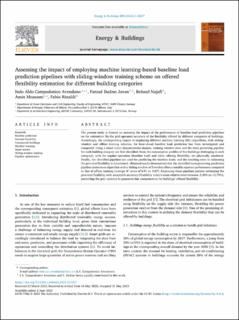| dc.contributor.author | Campodonico Avendano, Italo Aldo | |
| dc.contributor.author | Javan, Farzad Dadras | |
| dc.contributor.author | Najafi, Behzad | |
| dc.contributor.author | Moazami, Amin Nitter | |
| dc.contributor.author | Rinaldi, Fabio | |
| dc.date.accessioned | 2023-06-15T06:02:39Z | |
| dc.date.available | 2023-06-15T06:02:39Z | |
| dc.date.created | 2023-06-12T11:09:50Z | |
| dc.date.issued | 2023 | |
| dc.identifier.issn | 0378-7788 | |
| dc.identifier.uri | https://hdl.handle.net/11250/3071460 | |
| dc.description.abstract | The present study is focused on assessing the impact of the performance of baseline load prediction pipelines on the estimation (by the grid operator) accuracy of the flexibility offered by different categories of buildings. Accordingly, the corresponding impact of employing different machine learning (ML) algorithms, with sliding-window and offline training schemes, for hour-ahead baseline load prediction has been investigated and compared. Using a smart meter measurements dataset, training window sizes and the most promising pipeline for each building category are first identified. Next, the consumption profiles of five buildings (belonging to each category), with the regular operation (baseline load) and while offering flexibility, are physically simulated. Finally, the identified pipelines are used for predicting the baseline loads, and the resulting error in estimating the provided flexibility is determined. Obtained results demonstrate that the identified most promising prediction pipeline (extra trees algorithm with a sliding window of 5 weeks) offers a notably superior performance compared to that of offline training (average score of 0.91 vs. 0.87). Employing these pipelines permits estimating the provided flexibility with acceptable accuracy (flexibility index's mean relative error between -2.45% to +2.79%), permitting the grid operator to guarantee fair compensation for buildings' offered flexibility. | en_US |
| dc.language.iso | eng | en_US |
| dc.publisher | Elsevier | en_US |
| dc.rights | CC BY 4.0 | * |
| dc.rights.uri | http://creativecommons.org/licenses/by/4.0/deed.no | * |
| dc.subject | Baseline prediction; Demand flexibility; Commercial buildings; Machine learning; Smart meters; Sliding-window training; Pipeline optimization | en_US |
| dc.title | Assessing the impact of employing machine learning-based baseline load prediction pipelines with sliding-window training scheme on offered flexibility estimation for different building categories | en_US |
| dc.type | Peer reviewed | en_US |
| dc.type | Journal article | en_US |
| dc.description.version | publishedVersion | en_US |
| dc.rights.holder | © 2023 The authors | en_US |
| dc.subject.nsi | VDP::Teknologi: 500 | en_US |
| dc.source.volume | 294 | en_US |
| dc.source.journal | Energy and Buildings | en_US |
| dc.identifier.doi | 10.1016/j.enbuild.2023.113217 | |
| dc.identifier.cristin | 2153684 | |
| dc.source.articlenumber | 113217 | en_US |
| cristin.ispublished | true | |
| cristin.fulltext | original | |
| cristin.qualitycode | 2 | |

